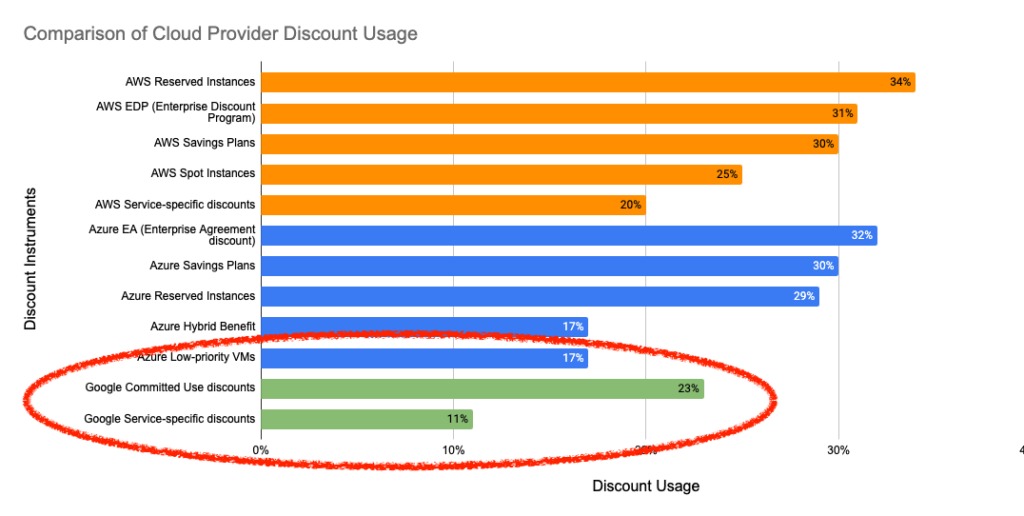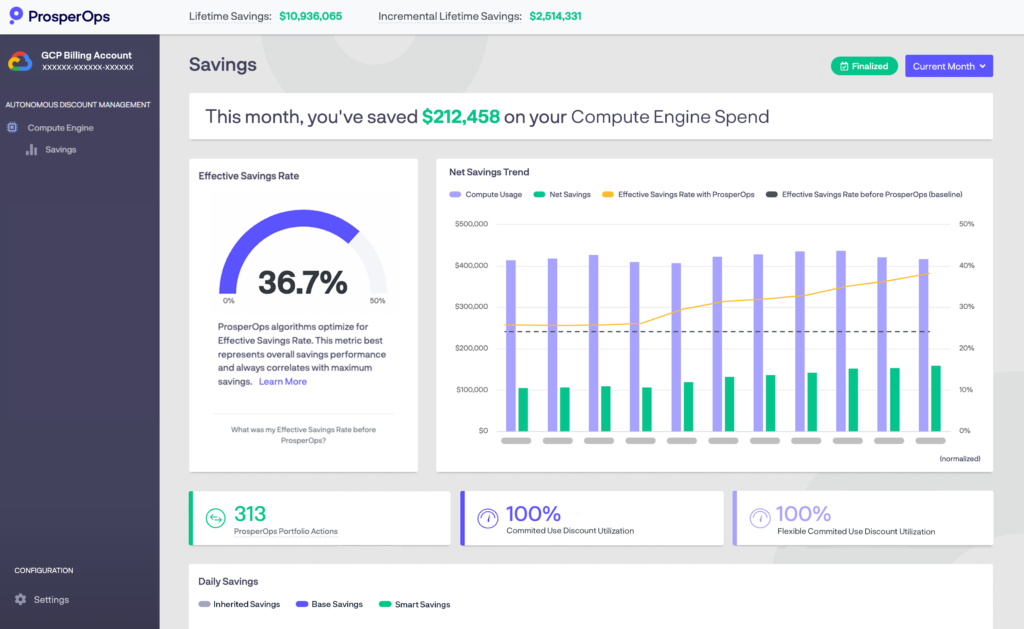- Managing Google Cloud’s Compute Engine discount instruments can be complicated to understand, complex to operationalize, and is challenging because of inelastic commitment risk.
- Autonomous Discount Management for Google Cloud Compute Engine is now available in Early Access.
- Pay less with zero engineering effort while minimizing commitment risk using our FinOps automation platform.
Alongside AWS, Google Cloud is one of the top public cloud providers with up to 18% market share and is one of the fastest growing hyperscalers at 26% YoY. However, it is estimated that roughly two-thirds of organizations are not using cloud provider pricing discounts, with Google Cloud having the lowest adoption of the hyperscalers. This means anywhere from 30%-60% of the on-demand cost is being left on the table.

Source: 2023 Flexera State of the Cloud Report
Navigating Google Cloud’s Discount Instruments
Google Cloud provides three main discount models for Compute Engine: Resource-based Committed Use Discounts (CUDs), Spend-based Committed Use Discounts (Flexible CUDs), and Sustained Use Discounts (SUDs).
- CUDs provide a discount in exchange for your commitment to use minimum levels of Compute Engine resources, including vCPU, memory, GPU, and local SSDs, for a particular region for a specific machine series. For example, you can purchase a 10 vCPU 1-year CUD for the E2 machine series for us-west1 with a 37% discount (or 3-year commitment with a 55% discount). CUDs are somewhat modifiable after they are purchased. You can upgrade the term of your commitments from 1-year to 3-year to get a bigger discount, merge them to consolidate resources, or split them to manage a portion of a commitment at a more granular level. However, when merging or splitting, commitments must have the same machine series, region, and duration, and these attributes cannot be modified. While CUDs are less flexible, these modifiable qualities make them somewhat similar to AWS Convertible Reserved Instances.
- Flexible CUDs are spend-based commitments that provide discounts off the on-demand price for committing to a level of hourly spend (similar to AWS Savings Plans). Compared to CUDs, Flexible CUDs provide horizontal flexibility as you are not restricted to a particular region or machine series. In exchange for this flexibility, Flexible CUDs generally provide lower discounts than CUDs, with flat discounts of 28% for 1-year commitments and 46% for 3-year commitments. They also only support vCPU and memory resources and can only be used for general-purpose and compute-optimized machine families. Flexible CUDs don’t support memory or accelerator-optimized machine families, meaning these machine types will remain uncovered unless a CUD is purchased for them. This is a limitation of Flexible CUDs compared to AWS Savings Plans (which support all EC2 instance types, Fargate, and Lambda globally).
- SUDs are the least complex and require no effort. When you use a Compute Engine resource for more than 25% of the billing month and do not have a commitment applied to it, SUDs are applied automatically to provide up to a 30% discount off of the on-demand cost. The downside is that they only apply to a few of the older Compute Engine machine series (roughly 6 out of 17 of them) as Google Cloud seems to be phasing SUDs out.
“We’ve seen increasing demand from our customers looking for a ProsperOps experience on Google Cloud. It’s now available, and we can’t wait to help customers optimize their cloud spend – simply and automatically.”
– Erik Carlin, Co-Founder and CPO of ProsperOps
Challenges of Managing Google Cloud Commitments
While Spend-based Committed Use Discounts and Resource-based Committed Use Discounts can help you reduce your Google Cloud bill materially, we find that managing them manually can be difficult at best and a costly mistake at worst (your bill can actually go up if you purchase the wrong commitments and they don’t cover the appropriate resources).
Here are a few key challenges with Google Cloud commitments:
- Complexities of tracking which machine series are covered – CUDs and Flexible CUDs each apply to a different subset of machine series. If one machine series is supported by CUDs, it might not be supported by Flexible CUDs. For example, CUDs cover the H3 compute-optimized machine series, but Flexible CUDs do not. Another example is that CUDs support all N1 machine types except f1-micro and g1-small. This is particularly “fun” to keep track of since the machine type names don’t match the machine series name. 🤪 Furthermore, Flexible CUD support can significantly lag the launch of a new machine series so it’s necessary to continually monitor Flexible CUD applicability.
- Overcommitment risk due to the immutability of CUDs – Unless you have a sophisticated optimization strategy with automation in place, you may run risk of overcommitment if your usage declines because CUDs are not exchangeable. You can also run the risk of overcommitment if you migrate to a different machine series or want to run your compute in a different region as CUDs are restricted to the region and machine series.
- Considerations for memory to vCPU ratio – CUD commitments are based on vCPU and memory. Each machine type has a different memory to vCPU ratio that must be carefully considered when managing commitments. For example, E2 high-memory machine types have 8 GB of memory per vCPU while E2 standard machine types have 4 GB of system memory per vCPU. Some machine series also support multiple preconfigured vCPU to CPU ratios and can also be customized. These variances make it challenging to track and ensure coverage levels are correct.
Autonomous Discount Management for Google Cloud Compute Engine
Today we are releasing Autonomous Discount Management for Compute Engine into Early Access. Early Access focuses on Resource-based CUD and Spend-based Flexible CUD management for Compute Engine vCPU and memory resources.
Given the complexities mentioned above, it’s difficult for engineers and FinOps teams to accurately and reliably optimize for savings at any given time without automation to simplify the process. Here is what makes our automation platform unique:
- Customized commitment portfolio based on your needs – Flexible CUDs and CUDs each have their own strengths and weaknesses as discount instruments. Our platform blends a portfolio of Flexible CUDs and CUDs to achieve the maximum savings based on your usage, machine types used, configured risk tolerance, etc.
- Set it and forget it – Our software is running in the background 24/7 and constantly working to optimize savings. We’re continually monitoring changes in usage, vCPU and memory ratios, CUD/Flexible CUD applicability and discount rates, and more, actively managing your commitment based discount portfolio so you don’t have to.
- Intelligent risk mitigation – We dynamically distribute commitments over time to achieve more flexibility against future changes in usage. For example if usage drops, ProsperOps will automatically stop purchasing new CUDs, allowing existing CUDs to expire to the level that precisely matches your lower usage. If your usage increases, ProsperOps will automatically adjust CUDs to match your new usage level. This activity is all governed by algorithms that account for risk by considering usage volatility, commitment type and amounts, remaining term duration, etc.

Easily visualize usage changes, savings outcomes, commitment burndown, and more in our console. Measure and benchmark against peers with Effective Savings Rate.
Sign Up for Early Access
We’re excited to extend our Autonomous Discount Management service to Google Cloud in Early Access! We’ve been working with multiple customers privately and are now ready to serve both new and existing ProsperOps customers. Our Early Access program is an opportunity for you to optimize your Google Cloud spend and help us refine our service to better meet your needs.
Are you ready to reduce your cloud costs on Google Cloud? For new customers, sign up HERE to create an account and get started. For existing customers, simply add a Google Cloud Billing Account via the ProsperOps console.
If you are interested in getting a live demo or learning more in-person, we will be at several upcoming events, starting with Google Next in April! Check out our events page.
Here’s to more savings!
Prosper On! 🖖
-Erik





